The History of Electronic Computers, Part 4: The Electronic Revolution
- Transfer
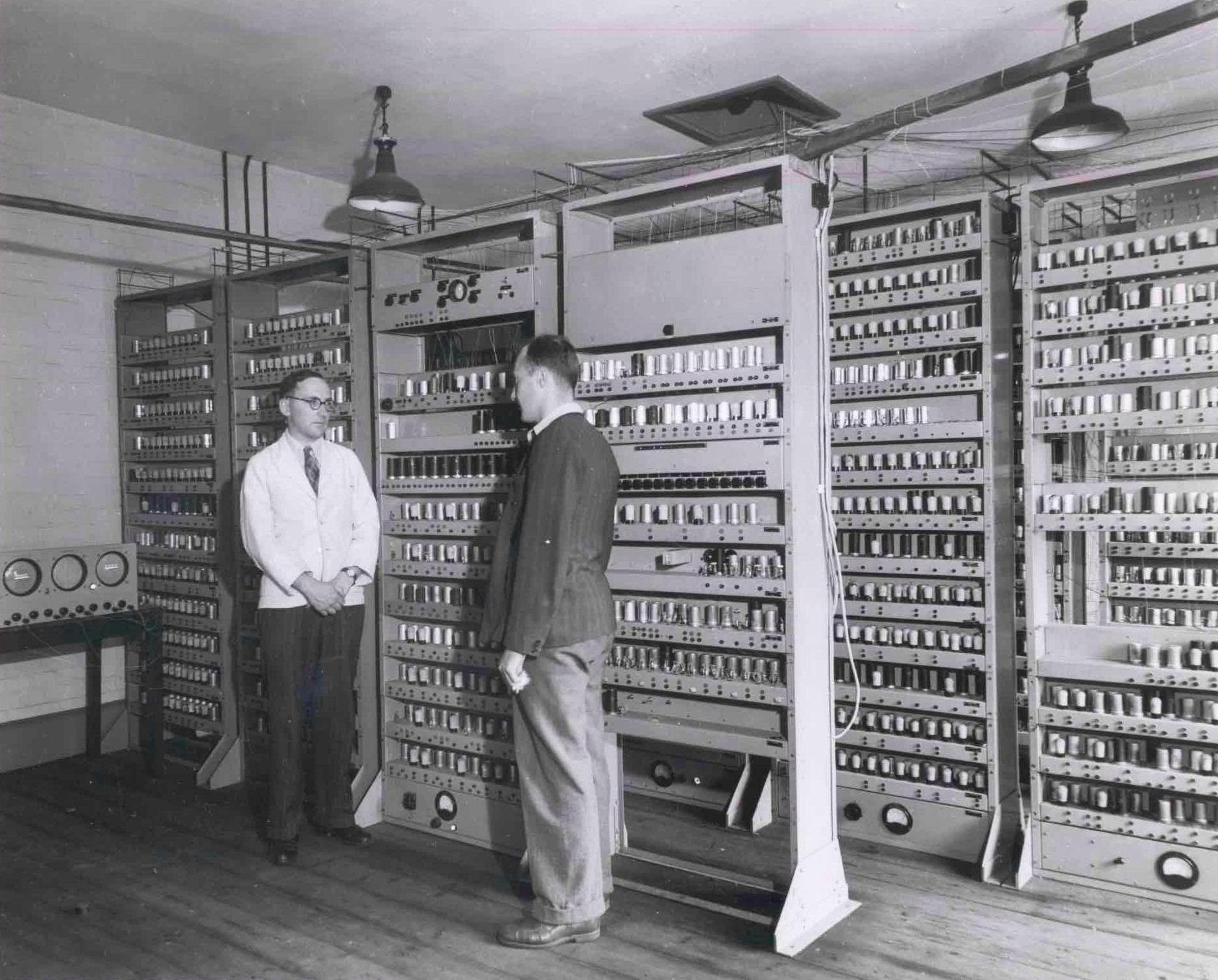
Other articles in the series:
- Relay history
- The history of electronic computers
- Transistor history
- Internet history
So far, we have consistently remembered each of the first three attempts to build a digital electronic computer: the Atanasov-Berry ABC computer, conceived by John Atanasov; a British Colossus project led by Tommy Flowers and ENIAC, created at the Moore School of the University of Pennsylvania. All these projects were, in fact, independent. Although John Mouchley, the main driving force behind the ENIAC project, knew about Atanasov’s work, the ENIAC scheme was nothing like ABC. If there was a common ancestor of the electronic computing device, then it was a modest Winn-Williams counter, the first device to use electronic lamps for digital storage, and allowing Atanasov, Flowers and Mowchli to embark on the path of creating electronic computers.
But only one of these three machines, however, played a role in the ensuing events. ABC never did any useful work, and by and large, those few people who knew about it forgot it. Two military vehicles proved that they could outperform any other existing computer in pure speed, however, the Colossus remained secret even after defeating Germany and Japan. Only ENIAC became widely known, and therefore became the holder of the electronic computing standard. And now everyone who wanted to create a computing device based on electron tubes could confirm the success of the Moore School for confirmation. The deep-seated skepticism of the engineering community, which met all such projects until 1945, has disappeared; skeptics either changed their minds or fell silent.
EDVAC Report
A document issued in 1945, based on the experience of creating and using ENIAC, set the tone for the development of computer technology in the world after the Second World War. It was called the “first draft of the EDVAC report” [Electronic Discrete Variable Automatic Computer], and provided the architecture pattern for the first computers programmed in the modern sense — that is, to execute commands extracted from high-speed memory. And although the exact origin of the ideas listed in it remains a matter of discussion, it was signed on behalf of the mathematician John von Neumann(née Janos Lajos Neumann). What is characteristic of the mathematics mind, the document also made the first attempt to abstract the computer circuitry from the specifications of a particular machine; he tried to separate the very essence of the structure of a computer from its various probable and random incarnations.
Von Neumann, born in Hungary, ended up at ENIAC via Princeton (New Jersey) and Los Alamos (New Mexico). In 1929, he, as an accomplished young mathematician, with notable contributions to set theory, quantum mechanics and game theory, left Europe in order to occupy a position at Princeton University. Four years later, the nearby Institute of Advanced Studies (IAS) offered him a life-long position in the state. Due to the growth of Nazism in Europe, von Neumann happily seized on the chance to remain indefinitely on the other side of the Atlantic - and became, after the fact, one of the first Jewish intellectual intellectuals from Nazi Europe. After the war, he lamented: "My feelings for Europe are the opposite of nostalgia, since every corner I know reminds me of a disappeared world and ruins that do not bring comfort."
Averted from his lost multinational Europe of his youth, von Neumann directed all his intellect to help the war machine that belonged to the country that sheltered him. Over the next five years, he traveled around the country, giving advice and advising on a wide range of new weapons projects, while somehow managing to become a co-author of a prolific game theory book. His most secret and important job as a consultant was his position at the Manhattan Project - an attempt to create an atomic bomb - whose research team was in Los Alamos (New Mexico). Robert Oppenheimer recruited him in the summer of 1943 to help with mathematical modeling of the project, and his calculations convinced the rest of the group to move in the direction of the bomb with the explosion directed inward. Such an explosion, thanks to explosives, moving fissionable material inward, was supposed to achieve a self-sustaining chain reaction. As a result, a huge number of calculations were required in order to achieve a perfect spherical explosion directed inward with the necessary pressure - and any mistake would lead to an interruption of the chain reaction and the fiasco of the bomb.
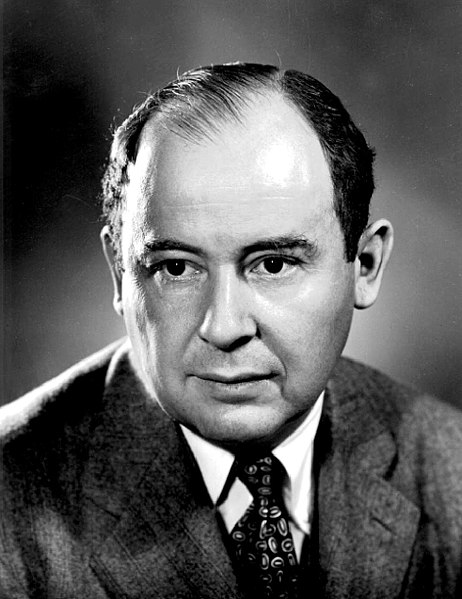
Von Neumann while working in Los Alamos
In Los Alamos, a group of twenty calculators worked with desk calculators, but they could not cope with the computing load. Scientists gave them IBM equipment for working with punch cards, but they still did not have time. They demanded improved equipment from IBM, received it in 1944, but still did not have time.
By then, von Neumann had added another set of places to visit for his ongoing cruise around the country: he traveled around all the possible locations for computer equipment that could be useful in Los Alamos. He wrote a letter to Warren Weaver, head of the Department of Applied Mathematics at the National Defense Research Committee (NDRC), and received some good tips. He went to Harvard to see Mark I, but he was already fully loaded with work for the fleet. He talked with George Stibitz and considered ordering Bell's relay computer for Los Alamos, but he abandoned this idea after learning how long it would take. He visited a group from Columbia University that combined several IBM computers into a larger automated system running Wallace Eckert,
However, Weaver did not include one project on the list that he gave von Neumann: ENIAC. He definitely knew about him: in his position as director of applied mathematics, he was obliged to monitor the progress of all the computing projects in the country. Weaver and the NDRC could certainly have doubts about the viability and timing of the ENIAC, but it is surprising that he did not even mention its existence.
Whatever the reason for this, but as a result, von Neumann found out about ENIAC only by chance meeting on a railway platform. This story was told by Herman Goldstein, an intermediary in the test lab of the Moore School in which the ENIAC was built. Goldstein ran into von Neumann at the Aberdeen train station in June 1944 - von Neumann left with one of his consultations, which he, as a member of the scientific advisory committee, gave at the Aberdeen Ballistic Research Laboratory. Goldstein knew von Neumann's reputation as a great man, and he began a conversation with him. Wanting to impress, he could not fail to mention a new and interesting project developing in Philadelphia. Von Neumann's approach instantly changed from a benevolent colleague to a tough controller, and he bombarded Goldstein with questions, related to the details of the new computer. He found an interesting new source of potential computer power for Los Alamos.
Von Neumann first visited Presper Eckert, John Mouchley, and other members of the ENIAC team in September 1944. He immediately fell in love with this project and added another item to his long list of counseling organizations. Both sides benefited from this. It is easy to see how the potential of high-speed electronic computing attracted von Neumann. ENIAC, or a similar machine, was able to overcome all the computational constraints that hindered the progress of the Manhattan project and many other existing or potential projects (however, Say's law, which is still valid today, ensured that the emergence of computational capabilities would soon cause equal demand for them) . For Moore's school, the blessing of such a recognized specialist as von Neumann meant the end of skepticism towards them. Moreover,
This is how von Neumann got involved in Eckert and Mouchley’s plan to create a follower of ENIAC. Together with German Goldstein and another ENIAC mathematician, Arthur Burks, they began to make parameter sketches for the second generation of electronic computers, and von Neumann summarized the ideas of this particular group in the report of the “first draft”. The new machine was supposed to become more powerful, get smoother contours, and, most importantly, to overcome the biggest barrier to using ENIAC - many hours of tuning for each new task, during which this powerful and extremely expensive computer just sat idle. Developers of electromechanical machines of the latest generations, Harvard Mark I and Bell relay computer avoided this by entering instructions into the computer using paper tape with holes punched in it - the operator could prepare paper, while the car solved other problems. However, such data entry would negate the speed advantage of electronics; no paper could feed data as fast as ENIAC could receive. (“Colossus” worked with paper using photoelectric sensors and each of its five computing modules absorbed data at a speed of 5000 characters per second, but this was only possible thanks to the fastest possible scrolling of the paper tape. Switching to an arbitrary place on the tape required a delay of 0, 5 s for every 5000 lines).
The solution to the problem described in the “first draft” consisted of moving the storage of instructions from the “external recording medium” to “memory” - this word was used for the first time in relation to computer data storage (von Neumann specifically used this and other biological terms in his work - he very interested in the work of the brain and the processes occurring in neurons). This idea was later called "program storage." However, this immediately led to another problem - which confused Atanasov, the excessive cost of electronic lamps. The “first draft” estimated that a computer capable of performing a wide range of computational tasks would require a memory of 250,000 binary numbers to store instructions and temporary data. Memory on electronic tubes of this size would cost millions of dollars and be completely unreliable.
A solution to the dilemma was proposed by Eckert, who worked in the early 1940s on research on radar under a contract between the Moore School and the Rad Lab of MIT, the central research center for radar technology in the United States. Specifically, Eckert worked on a radar system called the "Moving Target Indicator (MTI), which solved the problem of" exposure to the ground ": any noise on the radar screen created by buildings, hills and other stationary objects, making it difficult for the operator to isolate the important information - the size, location and speed of moving aircraft.
At MTI, the flare problem was solved with a device called the delay line.. He converted the electric pulses of the radar into sound waves, and then sent these waves through the mercury tube so that the sound came to the other end and turned back into an electric pulse at the moment when the radar re-scanned the same point in the sky (delay lines for propagation sound can also be used by other media: a different liquid, solid crystals, and even air, according to some sources, their idea was invented by a physicist from Bell's laboratories, William Shockley, about whom later). Any signal coming from the radar at the same time as the signal through the handset was considered a signal from a stationary object, and was removed.
Eckert realized that sound pulses in the delay line can be considered binary numbers - 1 indicates the presence of sound, 0 - its absence. One mercury tube may contain hundreds of such numbers, each of which passes through the line several times in a millisecond, that is, a computer would need to wait a couple of hundred microseconds to access the digit. At the same time, access to consecutive digits in the handset would be faster, since the digits were separated by only a few microseconds.
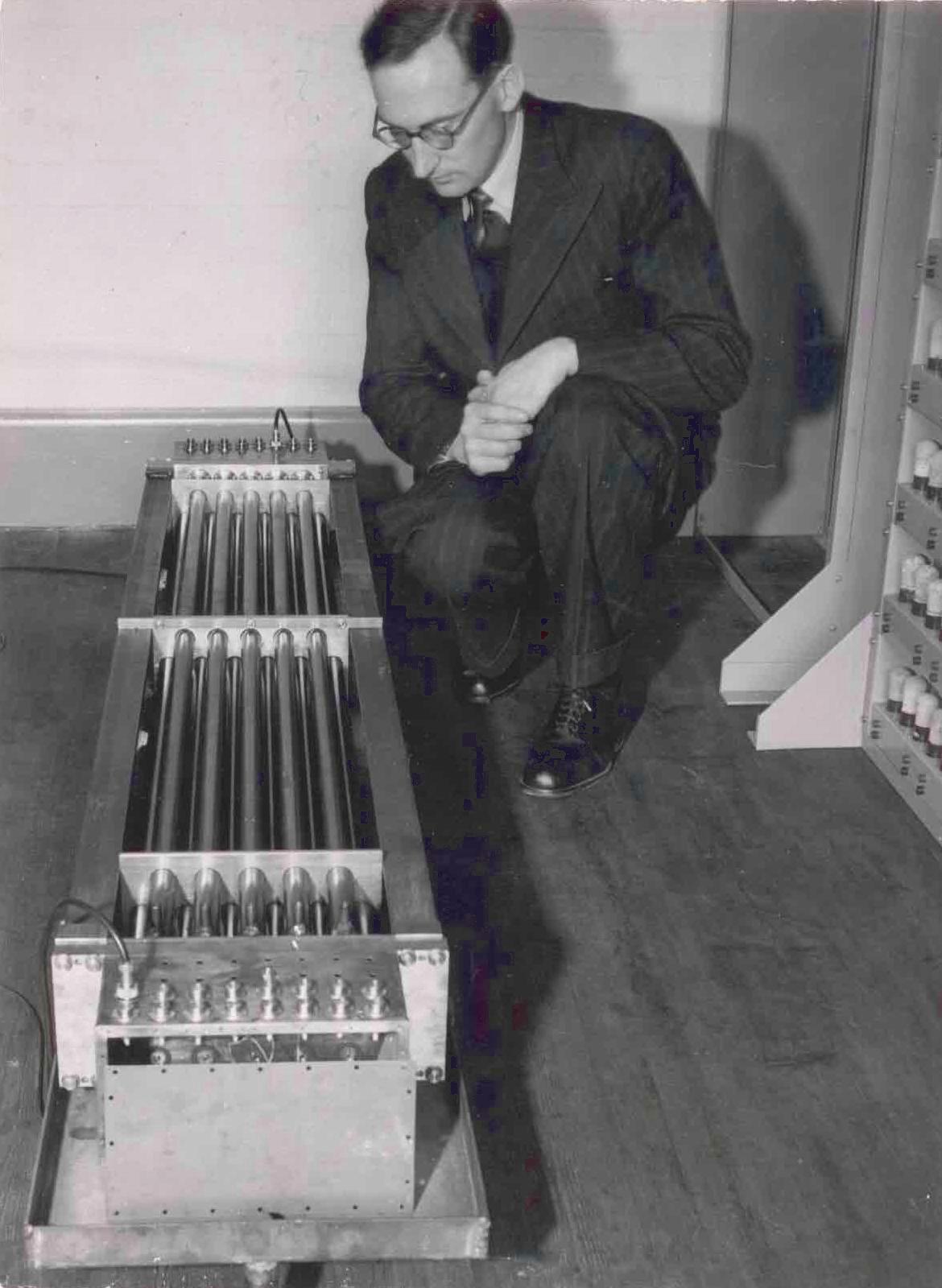
Mercury Delay Lines in the British EDSAC Computer
After solving the main problems in the computer circuitry, von Neumann collected the ideas of the entire group in the 101-page report of the “first draft” in the spring of 1945 and distributed it among the key figures of the second-generation EDVAC project. Pretty soon he entered other circles. The mathematician Leslie Comrie, for example, took a copy with him home to Britain, after a visit to Moore's school in 1946, and shared it with his colleagues. The distribution of the report provoked outrage among Eckert and Mauchly for two reasons: firstly, most of the merits in the development were attributed to the author of the draft, von Neumann. Secondly, all the main ideas contained in the system turned out, in fact, published from the point of view of the patent office, which interfered with their plans to commercialize the electronic computer.
The very foundation of the offense of Eckert and Mauchly, in turn, provoked the indignation of mathematicians: von Neumann, Goldstein and Burks. From their point of view, the report was an important new knowledge that needed to be disseminated as widely as possible according to the spirit of scientific progress. In addition, this entire enterprise was funded by the government, and therefore, by American taxpayers. They were repelled by the commercialism of Eckert and Mauchly's attempt to make money in war. Von Neumann wrote: "I would never have assumed the position of consultant at the university, knowing that I am advising a commercial group."
The ways of the factions diverged in 1946: Eckert and Mouchley opened their own company on the basis of a seemingly more secure patent based on ENIAC technology. At first they named their company Electronic Control Company, but the following year they renamed it Eckert-Mauchly Computer Corporation. Von Neumann returned to IAS to create an EDVAC-based computer, and Goldstein and Burks joined him. To prevent a recurrence of the situation with Eckert and Mouchley, they made sure that all the intellectual property of the new project became public domain.
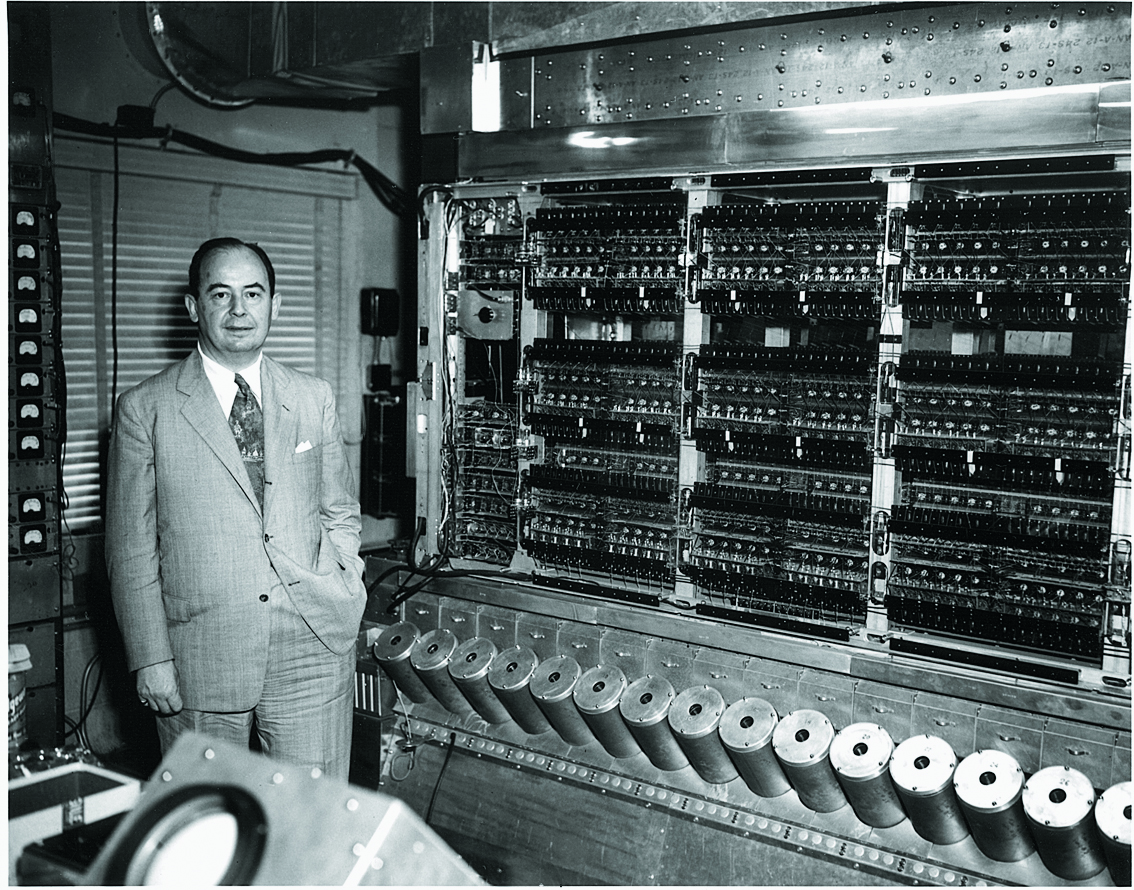
Von Neumann in front of an IAS computer built in 1951.
The Retreat Dedicated to Alan Turing
Among the people who saw the EDVAC report in roundabout ways was the British mathematician Alan Turing. Turing was not among the first scientists to create or come up with an automatic computer, electronic or any other, and some authors greatly exaggerated his role in the history of computer technology. However, we must give him credit as the first person who realized that computers can not just “calculate” something by trite processing large sequences of numbers. His main idea was that the information processed by the human mind can be represented as numbers, so any mental process can be turned into calculation.
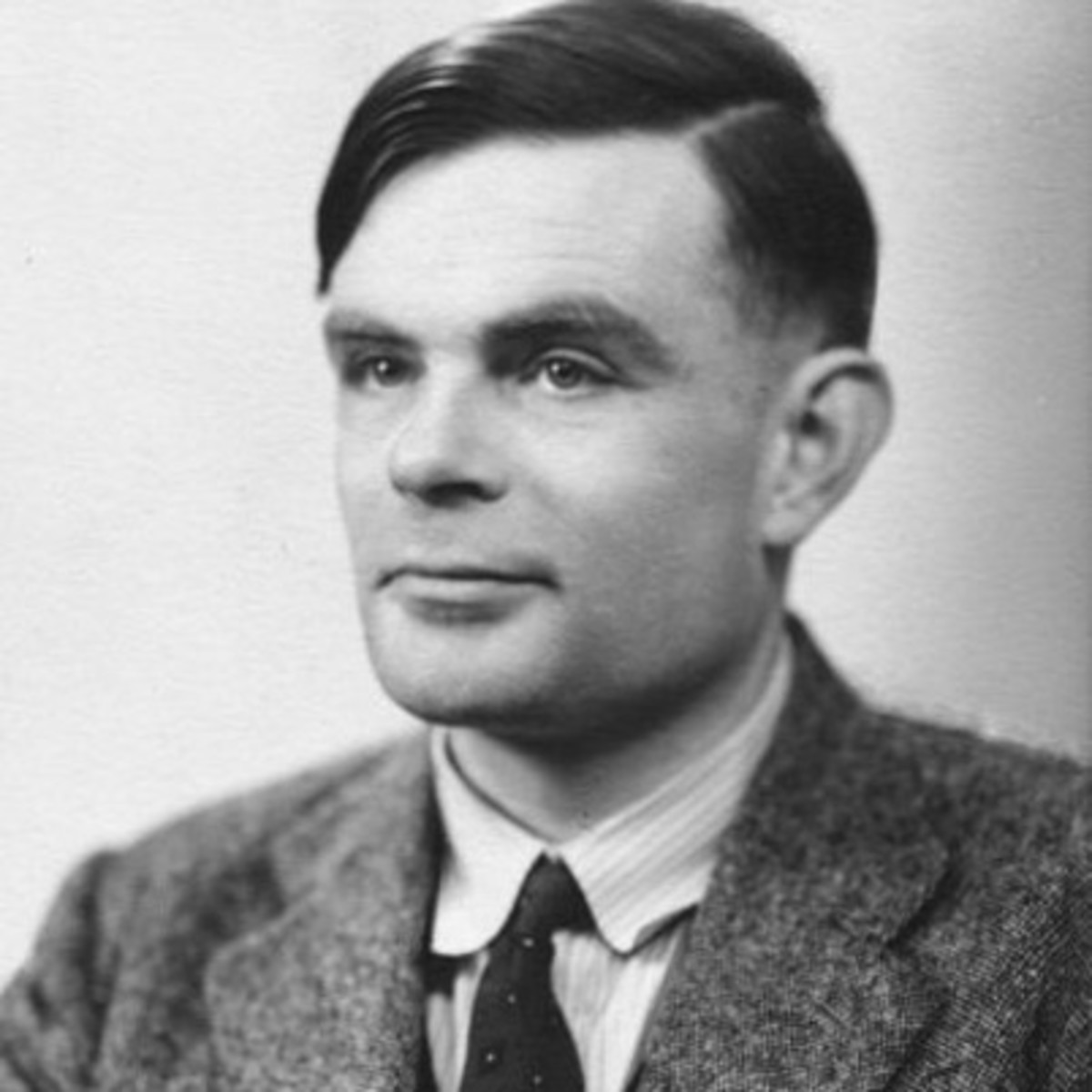
Alan Turing in 1951
At the end of 1945, Turing published his own report, which mentioned von Neumann, under the name "proposal of an electronic computer", and intended for the British State Physical Laboratory (NPL). He did not go so much into the specific design details of the proposed electronic computer. His scheme reflected the mind of a specialist in logic. He was not supposed to have special equipment for high-level functions, since they can be composed of low-level primitives; it would be an ugly outgrowth on the beautiful symmetry of the machine. Turing also did not allocate any linear memory for a computer program — data and instructions could coexist in memory, as these were just numbers. An instruction became an instruction only when it was interpreted like this (Turing's 1936 work “on calculated numbers” already examined the relationship between static data and dynamic instructions. He described what later became known as the “Turing machine” and showed how it can be turned into a number and feed as an input to a universal Turing machine capable of interpreting and executing any other Turing machine). Since Turing knew that numbers can represent any form of neatly defined information, he included in the list of tasks for solving on this calculator not only the construction of artillery tables and the solution of linear equations systems, but also the solution to puzzles and chess studies. how it can be turned into a number and fed as an input to a universal Turing machine that can interpret and execute any other Turing machine). Since Turing knew that numbers can represent any form of neatly defined information, he included in the list of tasks for solving on this calculator not only the construction of artillery tables and the solution of linear equations systems, but also the solution to puzzles and chess studies. how it can be turned into a number and fed as an input to a universal Turing machine that can interpret and execute any other Turing machine). Since Turing knew that numbers can represent any form of neatly defined information, he included in the list of tasks for solving on this calculator not only the construction of artillery tables and the solution of linear equations systems, but also the solution to puzzles and chess studies.
Automatic Turing Computing Machine (ACE) was never created in its original form. He was too slow, and he had to compete with the more zealous British computing projects for the best talents. The project skidded for several years, and then Turing lost interest in him. In 1950, the NPL made the Pilot ACE a smaller machine and a slightly different design, in addition, several other computer projects drew inspiration from the ACE architecture in the early 1950s. But she was not able to expand her influence, and she quickly went into oblivion.
But all this does not underestimate Turing's merits, it just helps put him in the right context. The importance of its influence on the history of computers is not based on the designs of computers of the 1950s, but on the theoretical basis prepared by him for computer science, which appeared in the 1960s. His early work on mathematical logic, which studied the boundaries of the computable and the uncalculable, became the fundamental texts of the new discipline.
Leisurely revolution
With the spread of news about ENIAC and the EDVAC report, Moore's school has become a place of pilgrimage. Many visitors came to study “at the feet of the masters”, especially from the USA and Britain. In order to streamline the flow of petitioners, the dean of the school in 1946 had to organize an invitation-based summer school on automatic computers. Lectures were given by such luminaries as Eckert, Mauchly, von Neumann, Burks, Goldstein and Howard Aiken (developer of the Harvard electromechanical computer Mark I).
Now almost everyone wanted to create machines according to the instructions from the EDVAC report (ironically, the first machine to run the program stored in memory was ENIAC itself, which was redone to use the instructions stored in memory in 1948. Only after that he began to work successfully in his new house, Aberdeen test site). Even in the names of new computer designs created in the 1940s and 50s, the influence of ENIAC and EDVAC was traced. Even if you do not take into account UNIVAC and BINAC (created in the new company of Eckert and Mouchley) and EDVAC itself (completed at Moore’s school after its founders left it), AVIDAC, CSIRAC, EDSAC, FLAC, ILLIAC, JOHNNIAC, ORDVAC still remain , SEAC, SILLIAC, SWAC and WEIZAC. Many of them directly copied the freely published IAS design (with minor modifications),
However, the electronic revolution developed gradually, step by step changing the existing order. The first EDVAC-style car appeared only in 1948, and it was only a small project proving the concept was working, the Manchester “kid” designed to confirm the viability of memory on Williams tubes(Most of the computers switched from mercury tubes to another type of memory, which also owes its origin to radar technology. Only instead of tubes it used a CRT screen. British engineer Frederick Williams was the first to think of how to solve the problem with the stability of this memory, as a result of which drives got his name). In 1949, four more cars were created: the full-size Manchester Mark I, EDSAC at the University of Cambridge, CSIRAC in Sydney (Australia) and the American BINAC - although the latter did not work. A small but steady stream of computers continued over the next five years.
Some authors described ENIAC as if it covered the past with a veil and instantly led us into the era of electronic computing. Because of this, real evidence was greatly distorted. “The advent of fully electronic ENIAC almost immediately made Mark I obsolete (although it worked successfully for another fifteen years after that),” wrote Katherine Fishman (The Computer Establishment (1982)]. This statement is so obviously contrary to itself that one would think that Miss Fishman's left hand did not know what her right hand was doing. You can, of course, write this off to the notes of a simple journalist. However, we find that a pair of real historians once again selects Mark I as a whipping boy, and writes: “Harvard Mark I was not only a technical dead end, he did not do anything very useful for fifteen years of his work. It was used in several projects of the navy, and there the machine proved to be useful enough for the navy to order several more computers for Aiken’s laboratory ”[Aspray and Campbell-Kelly]. Again, a clear contradiction.
In fact, relay computers had their own advantages, and they continued to work simultaneously with their electronic cousins. Several new electromechanical computers were created after World War II, and even in the early 1950s in Japan. Relay machines were easier to design, build, and maintain, and they didn't need as much electricity and air conditioning (to dissipate the sheer amount of heat emitted by thousands of light bulbs). ENIAC used 150 kW of electricity, 20 of which went to its cooling.
The US military continued to be the main consumer of computing power and did not neglect the "obsolete" electromechanical models. In the late 1940s, the army had four relay computers at its disposal, while the fleet had five. The ballistic research laboratory in Aberdeen has accumulated the largest concentration of computing power in the world, because ENIAC, relay calculators from Bell and IBM, and the old differential analyzer worked there. In the September 1949 report, everyone had their own place: ENIAC worked best with long simple calculations; Model V's Bell calculator handled complex calculations better thanks to an almost unlimited length of instruction film and the ability to work with a floating point, and IBM could process very large amounts of information stored in punch cards.
The best mark for the end of the electronic computing revolution will be not the year 1945, when ENIAC was born, but the 1954th, when the IBM 650 and 704 computers appeared. These were not the first commercial electronic computers, but they were the first to be produced by hundreds, and determined IBM's dominant position in computer industry lasting thirty years. In Thomas Kuhn's terminology , electronic computers have ceased to be a strange anomaly of the 1940s, existing only in the dreams of such outcasts as Atanasov and Mouchli; they have become normal science.
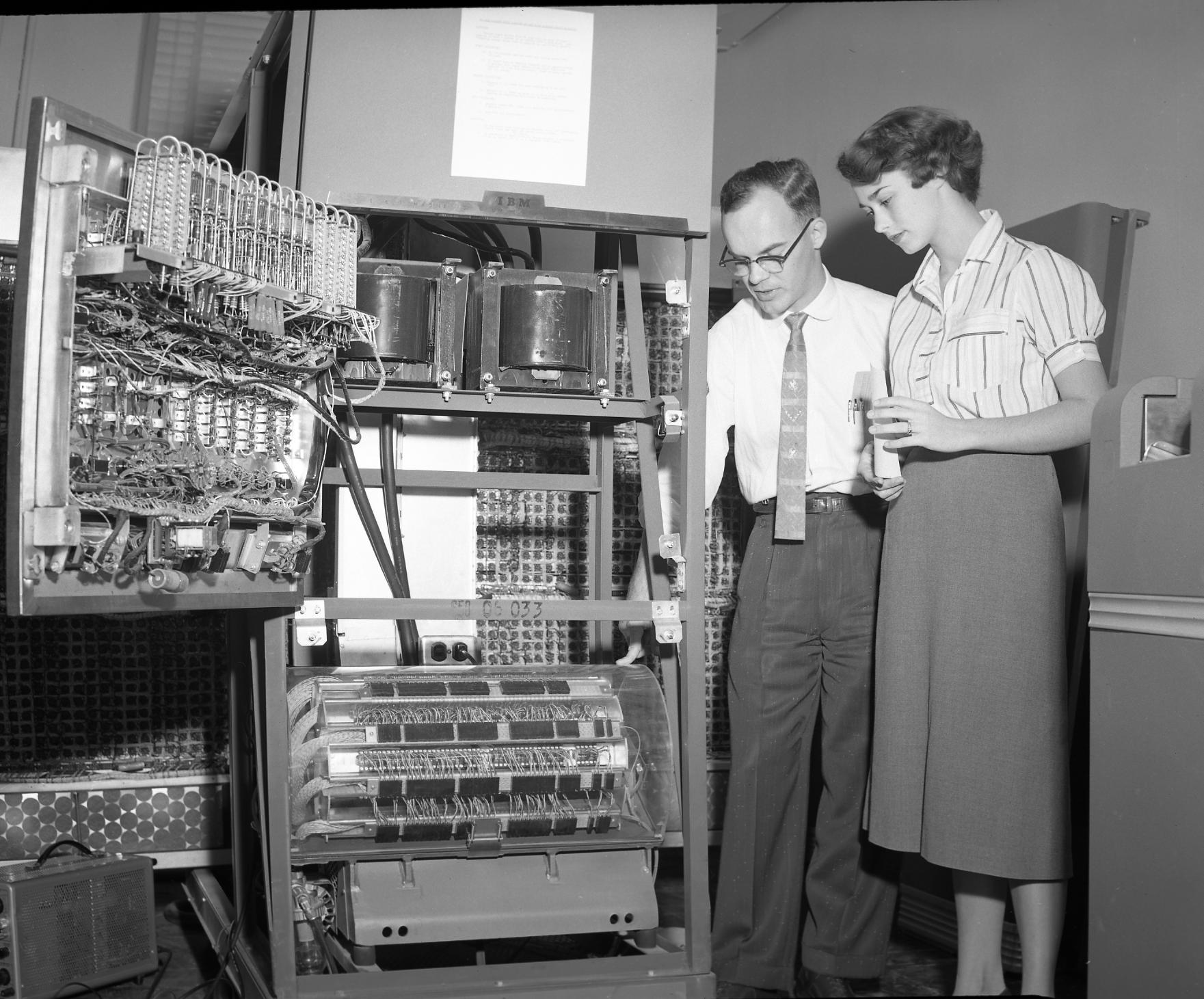
One of the many IBM 650 computers — in this case, an instance of Texas A&M University. The memory on the magnetic drum (bottom) made it relatively slow, but also relatively inexpensive.
Leaving the nest
By the mid-1950s, the circuit and design of digital computing equipment was decoupled from its origins, which lie in the switches and amplifiers of analog systems. The computer circuits of the 1930s and early 40s relied heavily on ideas from physics laboratories and radar, and especially the ideas of telecommunications engineers and research departments. Now computers have organized their own field, and specialists in this field have developed their own ideas, vocabulary and tools to solve their own problems.
A computer appeared in its modern sense, and therefore our relay historycoming to an end. However, the telecommunications world had another interesting trump card up its sleeve. The electronic lamp surpassed the relay due to the lack of moving parts. And the last relay in our history had the advantage in the complete absence of any internal parts. A harmless looking lump of matter, from which several wires stick out, appeared thanks to a new branch of electronics, known as "solid state".
Although the electronic lamps were high-speed, they remained expensive, large, hot and not particularly reliable. On them it was impossible to make, say, a laptop. Von Neumann wrote in 1948 that "it is unlikely that we will be able to exceed the number of switches by 10,000 (or perhaps several tens of thousands), while we are forced to apply current technology and philosophy)." A solid state relay enabled computers to go beyond these limits again and again, overcoming them many times; enter the everyday life of small businesses, schools, houses, household appliances and fit in pockets; create a magical digital country that permeates our current existence. And to find its origins, we need to rewind the clock fifty years ago, and return to the interesting early days of wireless technology.
What else to read:
- David Anderson, “Was the Manchester Baby conceived at Bletchley Park?”, British Computer Society (June 4th, 2004)
- William Aspray, John von Neumann and the Origins of Modern Computing (1990)
- Martin Campbell-Kelly and William Aspray, Computer: A History of the Information Machine (1996)
- Thomas Haigh, et. al., Eniac in Action (2016)
- John von Neumann, “First Draft of a Report on EDVAC” (1945)
- Alan Turing, “Proposed Electronic Calculator” (1945)
